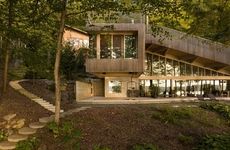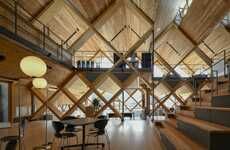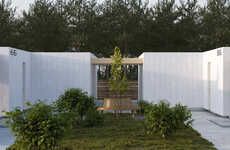
Mass Timber is Used for the Meyer Memorial Trust Building
Elena Rahman — March 16, 2022 — Eco
References: leverarchitecture & dezeen
The Meyer Memorial Trust building is located in Portland's Albina neighborhood. The building serves as the headquarters for the charitable foundation focused on racial, social, and economic justice.
To reduce the building's carbon footprint, the architects at Lever Architecture used structural plywood where possible throughout the building. The building is designed to embody the foundation's commitment to equity and sustainability. Lever Architecture used input from the organization's staff throughout the project to ensure it was creating a design suitable for all. The building boasts three levels and 19,800 square feet. It is roughly shaped rectangularly and stretches across a wedge-shaped site. Its facades are clad in grey-stained cedar and custom steel panels to create a play of light and shadow throughout the day.
Image Credit: Lever Architecture
To reduce the building's carbon footprint, the architects at Lever Architecture used structural plywood where possible throughout the building. The building is designed to embody the foundation's commitment to equity and sustainability. Lever Architecture used input from the organization's staff throughout the project to ensure it was creating a design suitable for all. The building boasts three levels and 19,800 square feet. It is roughly shaped rectangularly and stretches across a wedge-shaped site. Its facades are clad in grey-stained cedar and custom steel panels to create a play of light and shadow throughout the day.
Image Credit: Lever Architecture
Trend Themes
1. Mass Timber Construction - Opportunity for architects to utilize mass timber as a sustainable and carbon-reducing alternative to traditional building materials.
2. Equity-centered Design - Opportunity to embrace stakeholder input and design buildings that serve the needs of all that will utilize the space.
3. Green Building Practices - Opportunity for businesses to invest in sustainable building practices that reduce carbon emissions and promote environmental responsibility.
Industry Implications
1. Architecture - Opportunities for architects to incorporate sustainable design practices that prioritize reducing carbon emissions and promoting environmental responsibility.
2. Construction - Opportunities for construction companies to utilize sustainable materials and design practices that prioritize reducing carbon emissions and promoting environmental responsibility.
3. Charitable Foundations - Opportunities for charitable foundations to embrace equity-centered design and invest in environmentally sustainable buildings that align with their organizational values and goals.
4.5
Score
Popularity
Activity
Freshness























